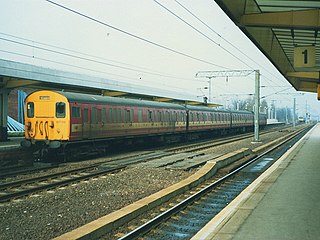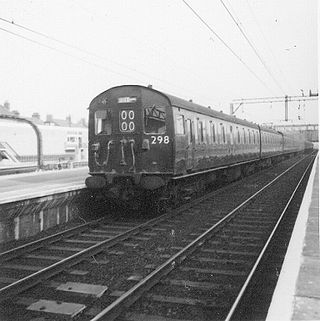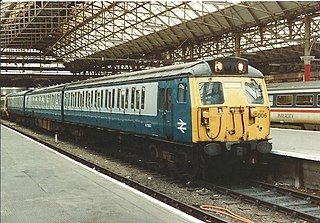
The British RailClass 411 (4CEP) electric multiple units were built at Eastleigh works from 1956–63 for the newly electrified main lines in Kent. These units, which used a British Railways Mark 1 bodyshell, were based on the earlier Southern Railway 4 COR design, built in 1937. Variants of the class 411 design included the class 410 and class 412 4 BEP units, which contained a buffet car in place of a standard trailer. They were later used on services in Sussex and Hampshire; following the privatisation of British Rail in 1995, the units were used by the Connex South Central, Connex South Eastern and South West Trains franchises. They were replaced by Juniper, Desiro, and Electrostar units. The fleet's lifespan was 49 years. These units are the longest-lived BR Mark 1 EMUs.

The British Rail Class 421 (4CIG) electric multiple units were built at BR's Holgate Road carriage works between 1964 and 1972. Units were built in two batches, and were initially introduced on services on the Brighton Main Line. Later units were introduced on services to Portsmouth. These units replaced older Southern Railway-designed units, such as the 5Bel "Brighton Belle" units, and 4Cor units. The fleet's lifespan was 46 years.

The British Rail Class 423, electric multiple unit passenger trains were mostly built by British Rail (BR) at York Works from 1967 to 1974, although the MBSOs and TSOs of the first 20, 7701-7720, were built at Derby Works. They have manually opening doors next to every seating row and were the last coaching stock built in this pattern for BR. They were mostly found working outer-suburban services in South London and rural services in Kent, Sussex and Hampshire, up to 2005 when they were finally replaced by Electrostar and Desiro units. The fleet had a working life of 38 years.

The British Rail Class 311 alternating current (AC) electric multiple units (EMU) were built by Cravens at Sheffield in 1967. They were intended for use on the line from Glasgow Central to Gourock and Wemyss Bay, which was electrified in 1967.

The British Rail Class 485 and British Rail Class 486 electrical multiple units were originally built for the London Electric Railway from 1923-31 as its 'Standard' tube stock. They were purchased by British Rail in 1967 and transported to the Isle of Wight to work 'mainline' services on the newly electrified Ryde to Shanklin line, where they worked for an additional quarter of a century. At the time of their purchase the units had already worked for over 40 years on the London Underground, but their introduction allowed the last steam locomotives on the line to be withdrawn.

Class 316 and Class 457 were TOPS classifications assigned to a single electric multiple unit (EMU) at different stages of its use as a prototype for the Networker series.

The British Rail Class 307 electric multiple units were built by BR at Eastleigh Works from 1954 to 1956. They were initially classified as AM7 before the introduction of TOPS.

The British Rail Class 321 are electric multiple unit (EMU) passenger trains built by British Rail Engineering Limited's Holgate Road carriage works in three batches between 1988 and 1991. The class uses alternating current (AC) overhead electrification. The design was successful and led to the development of the similar Class 320 and Class 322.

The British RailClass 303 electric multiple units, also known as "Blue Train" units, were introduced in 1960 for the electrification of the North Clyde and the Cathcart Circle lines in Strathclyde. They were initially classified as AM3 units before the introduction of the TOPS classification system, and were the dominant EMU on the Glasgow suburban railway network for over 25 years before being progressively phased out by newer rolling stock. The final units were withdrawn from service in 2002. The fleet's lifespan was 42 years.

The British Rail Class 504 was a unique type of electric multiple unit that ran on 1200 V DC third rail with side-contact current collection. All other mainline UK third rail has the electric "shoe" on top of the rail. The type was used only on the Bury Line between Manchester and Bury. They were built in 1959 at Wolverton Works, and the body was a standard type used for several electrification schemes of the time, but the high DC voltage through a side-contact third rail was unique in Britain. The trains replaced the previous 5-car units built by the Lancashire & Yorkshire Railway for the route, which had inaugurated this electrification scheme in 1916.

The British Rail Class 432 (4-REP) electric multiple unit passenger trains were built by BR at York Works from 1966 to 1967 and in 1974. The units were built to power the TC trailer units on services on the South West Main Line. Fifteen four-car units were eventually built. The motor coaches were new build, but the trailers were converted from Mk1 hauled stock. They were initially classified as Class 441 and numbered 3001–3015. This was later changed to Class 430, under which they spent the majority of their working lives. Shortly before withdrawal they were reclassified Class 432 and the units were renumbered as 2001–2015. The fleet had a lifespan of 26 years.

The British Rail Class 325 is an electric multiple unit (EMU) train owned by and operated for the Royal Mail to carry bulk mail. The class consists of four-car sets with dual-voltage 25 kV (AC) and 750 V (DC) power. While the Class 325 cabs bear a resemblance to the Networker family of DMUs and EMUs, the Class 325 is based on the Class 319.

The British Rail Class 501 electric multiple units were built in 1955/56 for use on the former LNWR/LMS suburban electric network of the London Midland Region. A total of 57 three-car units were built.

British Rail Class 503 trains were 65 mph (105 km/h) electric multiple units. They were introduced in two batches. The first were in 1938, by the London, Midland and Scottish Railway (LMS) with a further batch in 1956 by the then nationalised British Railways (BR). When introduced by the LMS, they were officially known as Class AM3. They were designed for, and operated on, the Wirral & Mersey lines from Liverpool to West Kirby, New Brighton, and Rock Ferry. There were few places on their network of closely spaced stations to attain their maximum speed, except for the open section between Moreton and Meols. All but one set were withdrawn and scrapped by 1985. The final set was used on special Merseyrail services until 1988, and this preserved set was kept at the Electric Railway Museum near Coventry until moved to the Locomotive Storage Ltd warehouse at Margate.

British Rail's Class 27 comprised 69 diesel locomotives built by the Birmingham Railway Carriage and Wagon Company (BRCW) during 1961 and 1962. They were a development of the earlier Class 26; both were originally classified as the BRCW Type 2. The Class 27s were numbered D5347-D5415.

The British Rail Class 302 was a type of electric multiple unit (EMU) introduced between 1958 and 1960 for outer suburban passenger services on the London, Tilbury and Southend line. This class of multiple unit was constructed using the Mark 1 bodyshell and was slam-door.

The British Rail Class 304 were AC electric multiple units designed and produced at British Rail's (BR) Wolverton Works.

The British Rail Class 305 was an alternating current (AC) electric multiple unit (EMU). Under the pre-1973 British Rail numbering system, the class was known as AM5. When TOPS was introduced, the class became Class 305.

The British RailClass 414 were two-car electric multiple units that were built between 1956 and 1963. They were withdrawn in 1995.

The British Rail Class 506 was a 3 carriage electric multiple unit (EMU) built for local services between Manchester, Glossop and Hadfield on the Woodhead Line, which was electrified in 1954 on the 1,500 V DC overhead system.




















